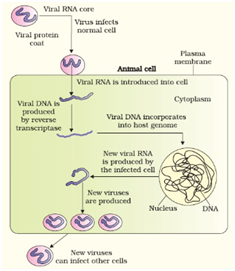The unusual red color of water that you see in the picture will most like be due to:

1. Cyanobacteria 2. Lichens 3. Chrysophytes 4. Dinoflagellates

Identify the organism shown in the figure and the function of the structures shown by arrow:
1. Paramoecium, trophic functions
2. Euglena, sexual reproduction
3. Paramoecium, osmoregulation
4. Euglena, photoreception
A phage with the following life cycle will be called as:
1. Temperate
2. Virulent
3. Prophage
4. Prion
Consider the given statements regarding cynobacteria [blue green algae]:
I. Some cyanobacteria can fix atmospheric nitrogen in aerobic conditions by means of specialized cells called heterocysts.
II. Cyanobacteria such as Anabaena (a symbiont of the leguminous plants) can provide rice plantations with biofertilizer.
III. Many cyanobacteria form non motile filaments of cells, called hormogonia during unfavorable conditions
The incorrect statements are:
1. None
2. Only I and II
3. Only III
4. I, II and III
The following diagram shows:
1. Asexual reproduction in lichens
2. Size restitution in diatoms
3. Formation of cellulose plates in dinoflagellates
4. Sporogony in malarial parasite
The given diagram shows the formation of:
1. Conidia on sporangiophores
2. Ascospores on asci
3. Basidiospores on a basidium
4. Conidia on conidiophores
Which of the following will be the virus for which the typical life cycle would be as shown in the given figure?

1. Reovirus
2. Rotavirus
3. Arbovirus
4. Retrovirus
Identify the incorrect statement regarding the novel corona virus [2019-nCoV]:
1. It is a double-stranded RNA coronavirus
2. The virus is thought to have a zoonotic origin
3. Human-to-human transmission of the virus has been confirmed
4. Mode of transmission is through respiratory droplets from coughs and sneezes
The fruiting body of a fungus contains many structures with eight haploid spores lined up in a row. This fungus belongs to the class:
| 1. | phycomycete | 2. | ascomycete |
| 3. | deuteromycete | 4. | basidiomycete |
In an individual basidiomycete fungus, the size of the following [largest to smallest] will be:
| a. | basidiocarp | b. | basidium |
| c. | basidiospore | d. | mycelium |
| e. | gill |
| 1. | d, e, a, b, c | 2. | e, a, d, b, c |
| 3. | e, a, d, c, b | 4. | d, a, e, b, c |










